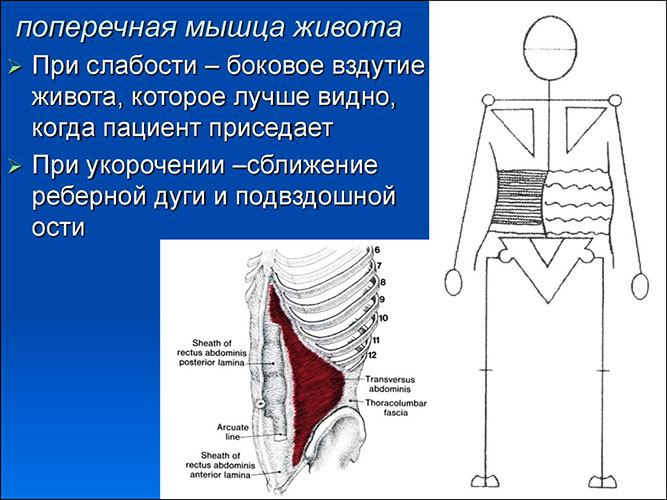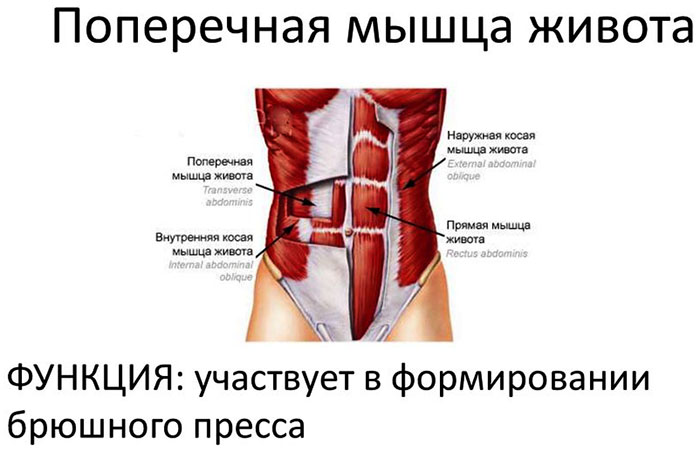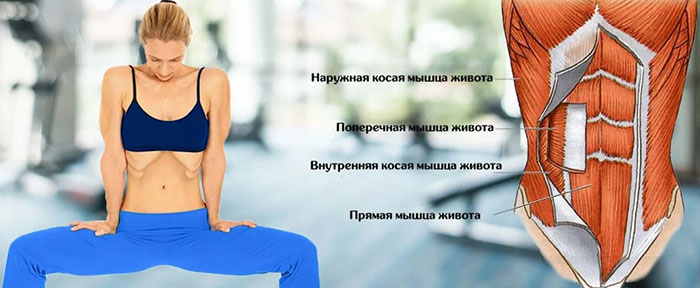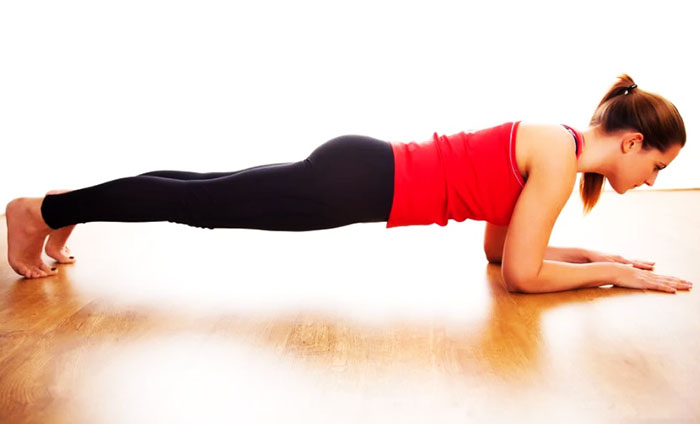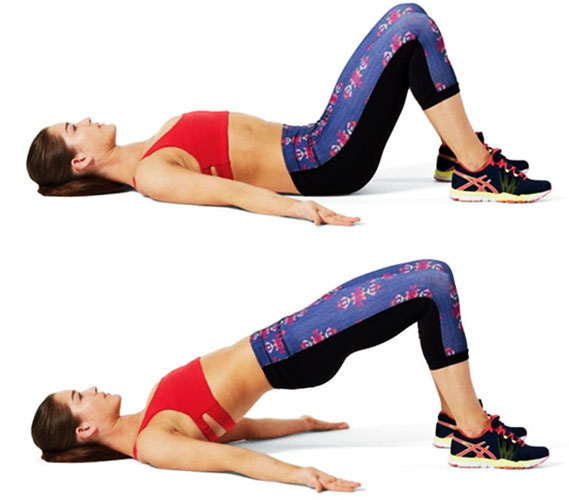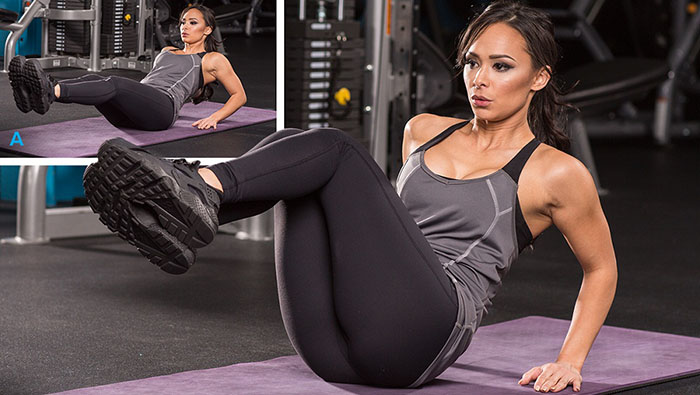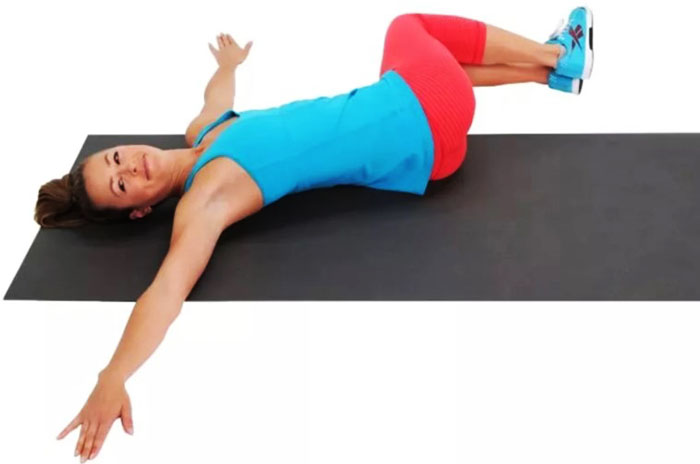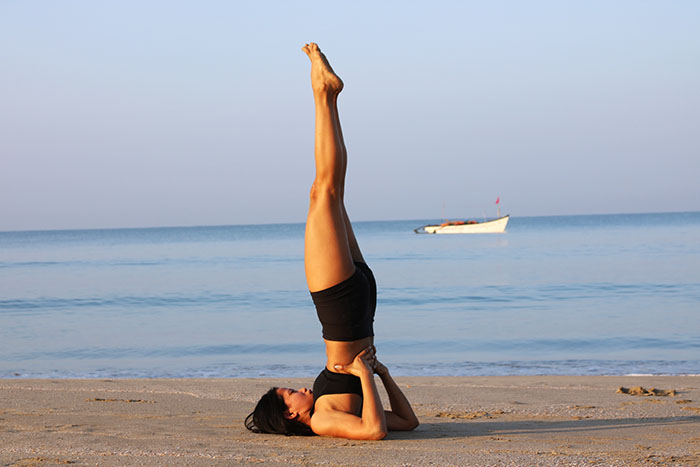One of the most important muscles for building an attractive abdominal relief - the transverse abdominal muscle. It has several functional tasks, including leading and motor tasks. Anatomy ranks it under the skeletal muscle category.
Characteristic
The transverse abdominal muscle is part of the structure of the internal musculature of the abdominal cavity and encircles the lateral surfaces of this area of the body. Together with the oblique muscles, the transverse is a compacted ring that surrounds the waist. It is the deepest layer of the abdominal musculature.
The transverse abdominal muscle, the anatomy of which allows it to be pumped well with the help of a special set of exercises, encircles the body and gives it elasticity. It tightens the bones of the ribs, forms a three-dimensional appearance of the abdominal (abdominal) cavity and maintains the internal organs in an anatomically correct position.
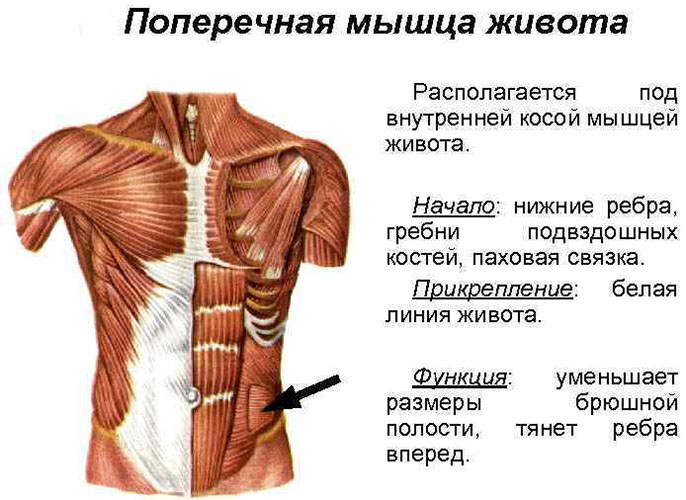
The muscle group consisting of the transverse and oblique muscles takes on about 40% of the mechanical load of the spine, directed vertically. Due to this, the correct posture is formed and the body is supported during movement.
The transverse muscle is covered by its own fascia - a protective sheath of connective tissue that is found in all muscles, bloodstreams and nerve fibers. This is a kind of protective cylindrical case that performs support and trophic (transport) functions.
The transverse abdominal muscle is located between the skeletal bones to provide support. During motor activity, it involves the trunk and articular joints in the process, playing an important role in their flexibility.
This muscular structure supports the normal functioning of the spinous muscle fibers filling the space between the segments of the spinal column. It consists of semi-awned, multiparticulate and rotational biological tissues.
Thanks to the transverse muscle of the abdominal cavity, this structure functions normally. It provides significant flexibility and mobility of the spinal column.
The transverse muscle is involved in almost all training complexes to strengthen the development of the abdominal press. Anatomically, it is a thin plate consisting of muscle fibers and strong flexible tendons.
The beams of the biological structure are directed transversely in relation to the spinal column, for which it got its name. When contracted, this muscle regulates the waist, lifting the abdomen and bringing the rib bones to the midline.
Functions and properties
The transverse abdominal muscular structure forms the 3rd deepest layer of the inner waist wall. Perpendicular to the body, it is responsible for the motor function of the torso and spinal column. Transverse fibers are involved in flexion of the trunk, stabilization of the lumbar spine.
They are part of the structure of the muscular corset of the body. Therefore, it is important to develop and train the transverse abdominal muscle. Due to excessive physical strain, this muscle can hurt and become inflamed.
Discomfort often manifests itself spontaneously, accompanied by hyperthermia (increased body temperature), weakness.Therefore, it is important to maintain the transverse muscle in proper functional condition through sports training according to a professionally designed program.
For its innervation (connection with the central nervous system), the intercostal, hypogastric-iliac and inguinal nerves are responsible. The blood supply to the transverse muscle of the abdominal cavity is entrusted to the posterior intercostal, upper and lower epigastric, muscular-diaphragmatic vessels.
The main functions of the organ:
- leading;
- supportive;
- contractile;
- regulating abdominal volume.
The transverse abdominal muscle, the anatomy of which hides it in the deep layers of the muscular structures of the abdominal cavity, needs constant training and strengthening of tone, which will avoid numerous health problems.
Anatomy and structure
It is the thinnest and deepest of all the wide structures of the abdominal musculature. It is attached to the inner surface of the 6 lower rib bones and extends to the iliac crest.
Further, the transverse muscle bifurcates and stretches by both processes to the lateral inguinal ligament. From this place, muscle fibers and connective tissues are located in the transverse-medial plane and pass into the aponeurosis - a plate of wide tendons formed by dense collagen fibers.
Such tissues differ from other tendons by the absence of blood vessels and nerve endings. From the point of view of not only sports development, but also in the aspect of strengthening physical health, the transverse muscle is one of the most important structural and functional elements of the abdominal zone.
Exercise is an effective prevention of hernia. This is especially true for those who lead a sedentary life and are engaged in sedentary work.
Transverse Abdominal Muscle Training and Abdominal Development:
- tighten the stomach;
- form an attractive figure;
- increase the general tone of the body;
- prevent the appearance of hernial seals;
- improve the support of internal organs in a natural and anatomically correct position;
- reduce fatigue during physical exertion.
For women, regular implementation of a set of exercises for training the transverse muscle makes it possible to acquire a slender waist and a flat stomach.
The main set of exercises
It's not just the gym that is suitable for strengthening the abdominal muscles. You can train the transverse muscle at home without using specialized sports equipment.
For the effectiveness of classes, compliance with the following rules is required:
- You need to work out the abdominal muscles every day separately or 3-4 times a week according to a specially compiled comprehensive program.
- The recommended training duration is 1 hour, and the duration of a single exercise should not exceed 15 minutes.
- Both morning and evening hours are suitable for classes, depending on the individual circadian rhythms.
- For a comfortable organization of the training process at home, you will need a gymnastic mat and dumbbells of a small mass for complex training of all groups of abdominal muscles. Girls are advised to get an elastic hair band.
- Before the main set of exercises, you need to warm up for 5-7 minutes.
- Classes should be completed with breathing exercises to normalize the heartbeat and minimize post-workout soreness.
Aerobic exercise will increase the effectiveness of the main training complex, restore local lymph flow and systemic circulation. Below are common exercises for strengthening the transverse abdominal muscles for girls.
"Vacuum"
It is a quick way to develop abdominal muscles and body shape. The "vacuum" exercise should be done daily as part of a comprehensive program. Respiratory rhythm should be clearly controlled and technique should be followed.
The transverse abdominal muscle is well worked out in a "vacuum" way only if done correctly.The anatomy of this deep-seated structure around the waist allows you to create an attractive figure in no time.
Algorithm for the exercise:
- It is necessary to position the body in a comfortable upright position, place your hands on the hips, spread the feet to the width of the shoulder girdle, bend the knee slightly.
- Take a deep breath through the nose to fill the lungs with atmospheric mixture and draw in the stomach.
- The air is retained for 2-3 seconds, without relaxing the abdominal muscles. Exhaling movements should be done three times in a row, each time straining the muscles more and more and keeping the stomach in a taut state.
- Next, you need to stop breathing for an extremely comfortable time for yourself - usually 5-7 seconds. Keep both the upper and lower abdominal zones tense.
After this time, a calm nasal breath is taken. At the same time, slowly relax the abdominal muscles.
"Anti-vacuum" exercise
Antipode of the previous technique. Both load options can be incorporated into a single weekly training system.
"Anti-vacuum" is performed daily according to the following standard algorithm:
- Take a comfortable vertical or horizontal position for exercise.
- Hands should be pressed tightly to the side surfaces of the body, legs should be spread shoulder-width apart and slightly bent at the knees.
- Deeply suck air into the lungs through the nose. The stomach is strained as much as possible.
- Exhale slowly without relaxing the abdominal muscles.
- Without pause, they again take air into the lungs. The abdomen in this part of the exercise is not drawn in, but rather bulge forward while simultaneously relaxing the abdominal muscles.
Without breathing, they fix the body for an extremely comfortable period of time, then calmly release the air through the mouth.
"Plank"
The transverse abdominal muscle, the anatomy of which provides the highest-quality workout when exercising in the morning on an empty stomach, develops well with the help of special static loads. One of the most effective exercises of this type is called the plank.
Execution technique:
- Starting position - horizontal, lying on a gymnastic mat.
- An even distribution of load forces ensures the lifting of the body. The fulcrum is the parallel forearms and fingers of the erect lower limbs.
- When performing the exercise, it is necessary to ensure that the lumbar zone does not bend. The distance from the abdomen to the floor should remain constant until you return to the starting position. It is necessary to maintain the rhythm of breathing through the mouth. Correct execution ensures fast strengthening of the abdominal muscles.
- Nasal breathing is successively alternated with oral breathing.
You need to get out slowly, gradually relaxing all the muscle groups involved.
"Pelvic bridge"
The transverse abdominal muscle and berry muscles are developed comprehensively with this exercise. It is recommended to perform a multidirectional load lesson every day.
The standard training technique is as follows:
- Starting position - lying on your back.
- Hands are folded behind the head or lowered along the body. The legs are slightly bent at the knees and apart shoulder-width apart. The heels are pressed firmly against the surface of the floor or gym mat.
- Deeply suck in air through the mouth and lift the buttocks, maximally straining the abdominal muscles. The feet are not lifted off the surface.
- At the extreme upper point of the range of motion, several rhythmic jerks are performed with the buttocks and the thigh muscles are strained.
- After 5-6 sec. slowly lower the body to its original position with simultaneous nasal exhalation.
The pauses between lifts, gluteal movements and muscle tension should be kept to a minimum.
Load with pulling the torso to the legs
The training technique is focused on the integrated development of all muscle groups, including the transverse muscles.
Standard execution algorithm:
- The starting position is horizontal on the back.
- The hands are placed behind the head, the legs are slightly bent at the knees, the legs are spread apart to the distance of the shoulders, the feet are firmly pressed to the surface.
- Next, the legs need to be torn off the floor or gymnastic mat, bending the knees at right angles. The feet are stretched and tense.
- Exhale, lifting the upper body from the surface, pulling the chin to the chest to reduce the load on the cervical muscles.
- The tension of the abdominal muscles at the highest point of the training movement should be maximized.
Without pause, you should return the body to its original position. During the exercise, the knees should be kept bent at a right angle.
"Screw"
Exercise allows you to effectively work out the abdominal muscles without undue stress on the spine.
Execution algorithm:
- Starting position - lying on your back. Hands are under the back of the head, legs are slightly bent at the knee joints and torn off the surface.
- On exhalation, the abdominal part of the body and the lower limbs are turned to the side, imitating the movements of a twisted screw. The distance between the surface and the knees should not exceed 5 cm.
- A deep nasal breath is taken and the body is returned to its original position, with the involvement of the abdominal muscles in the process. The cycle of training movements does not provide for pauses.
Turning the knees to the left and to the right alternate, trying to touch the surface with them.
"Birch"
The exercise is aimed at strengthening the deep transverse muscle layers of the abdominal cavity and superficial musculature. With it, girls can form a flat belly and a narrow waist.
The algorithm consists in the sequential execution of the following actions:
- Initially, they take a horizontal position, sitting on their back.
- The palms are placed under the back of the head, the legs are stretched naturally.
- Take a deep breath with your mouth. The legs are lifted at right angles to the body. The knee joints do not bend.
- On exhalation, only the abdominal muscles should be tightened and the buttocks should be torn as far from the surface as possible, without changing the position of the lower extremities.
- In this position, they linger for 3-4 seconds, then slowly lower the buttocks to the surface, without weakening muscle tension. After 2-3 seconds. the cycle of movements is repeated.
After completing the exercise, you need to slowly lower your legs and take a deep breath.
Week schedule
The transverse abdominal muscle, the anatomy of which is responsible for the volume and flexibility of the waist, is trained most efficiently in a complex way.
The weekly homework program for girls is shown in the table.
| Exercise | The number of approaches and repetitions |
| "Vacuum" | The recommended number of repetitions of aerobic exercise is 10 cycles of inhalation / exhalation and tension / relaxation of the abdominal muscles. Holding your breath - 5-10 sec. |
| "Anti-vacuum" | The optimal number of approaches is 5-10. Between them, you need to take short breaks, about 10-15 seconds each, to avoid dizziness from oxygen starvation. |
| "Plank" | From a prone position, they slowly rise to the support points and freeze for 60 seconds. The number of repetitions is 3-5. |
| "Screw" | Throughout the workout, you need to do 4 sets of 15 spiral movements in each. The pause duration between cycles is no more than 10 seconds. |
| "Pelvic bridge" | The recommended number of repetitions is 30, approaches 5. The interval between exercise cycles should not exceed 1 min. |
| Pulling up the torso to the legs | It is necessary to do 4 sets of 20 cycles during the workout. The duration of the interval between lifting the body is no more than 10 seconds. |
| "Birch" | The recommended number of sets is 3 x 20 buttock lifts. The pause between cycles is no more than 10 seconds. |
At the initial stage of training, it is enough to perform a set of exercises 3 times a week. When the abdominal muscles are strengthened and there is no soreness, you need to move on to daily activities.
When to expect an effect
With regular exercise, adherence to the training scheme and exercise technique, the first results will become noticeable in 3-4 weeks.
The rate of strengthening of the transverse muscles of the abdominal cavity and the severity of progress are determined by a combination of the following factors:
- initial anatomical data - the more weight, the faster the result will appear, which is explained by the activation of metabolic and metabolic processes, the release of the body from excess fluid;
- initial athletic training - the better it is, the more load the body can withstand, so progress comes faster;
- physiological characteristics - the metabolism of young people is more intense, and the muscles are more elastic and stronger than those of those who have passed the 40-year mark, which makes it difficult to achieve the result of sports activities.
- Diligence in the training process - the accuracy of the exercises significantly brings progress.
For physiological reasons, in women, fat deposits always accumulate in the lower abdomen, making the waist vague and expressionless. Therefore, you can quickly achieve an ideal figure only by combining sports activities with dietary nutrition.
A set of exercises designed to develop the transverse abdominal muscle requires a scrupulous approach and regularity of exercises. The anatomy of the muscular structure does not make it difficult to pump. This is how it differs from surface fibers.
Video about the transverse abdominal muscle
How to pump up the transverse abdominal muscle:

